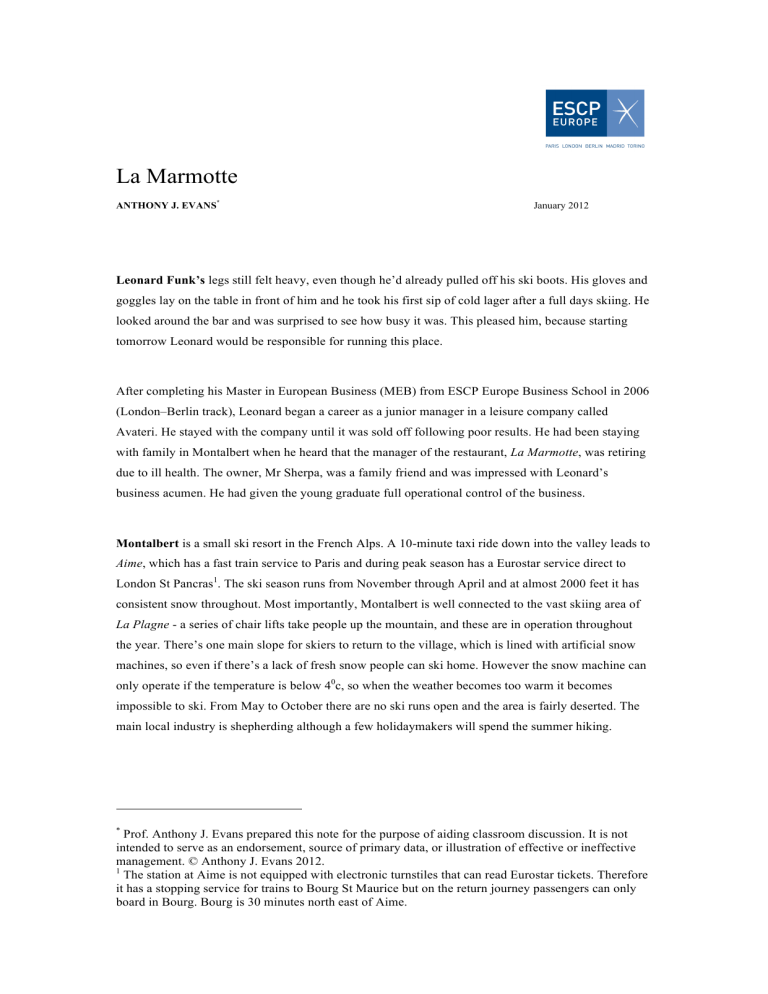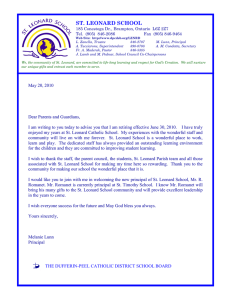
La Marmotte ANTHONY J. EVANS* January 2012 Leonard Funk’s legs still felt heavy, even though he’d already pulled off his ski boots. His gloves and goggles lay on the table in front of him and he took his first sip of cold lager after a full days skiing. He looked around the bar and was surprised to see how busy it was. This pleased him, because starting tomorrow Leonard would be responsible for running this place. After completing his Master in European Business (MEB) from ESCP Europe Business School in 2006 (London–Berlin track), Leonard began a career as a junior manager in a leisure company called Avateri. He stayed with the company until it was sold off following poor results. He had been staying with family in Montalbert when he heard that the manager of the restaurant, La Marmotte, was retiring due to ill health. The owner, Mr Sherpa, was a family friend and was impressed with Leonard’s business acumen. He had given the young graduate full operational control of the business. Montalbert is a small ski resort in the French Alps. A 10-minute taxi ride down into the valley leads to Aime, which has a fast train service to Paris and during peak season has a Eurostar service direct to London St Pancras1. The ski season runs from November through April and at almost 2000 feet it has consistent snow throughout. Most importantly, Montalbert is well connected to the vast skiing area of La Plagne - a series of chair lifts take people up the mountain, and these are in operation throughout the year. There’s one main slope for skiers to return to the village, which is lined with artificial snow machines, so even if there’s a lack of fresh snow people can ski home. However the snow machine can only operate if the temperature is below 40c, so when the weather becomes too warm it becomes impossible to ski. From May to October there are no ski runs open and the area is fairly deserted. The main local industry is shepherding although a few holidaymakers will spend the summer hiking. * Prof. Anthony J. Evans prepared this note for the purpose of aiding classroom discussion. It is not intended to serve as an endorsement, source of primary data, or illustration of effective or ineffective management. © Anthony J. Evans 2012. 1 The station at Aime is not equipped with electronic turnstiles that can read Eurostar tickets. Therefore it has a stopping service for trains to Bourg St Maurice but on the return journey passengers can only board in Bourg. Bourg is 30 minutes north east of Aime. La Marmotte is a restaurant at the basin of the main slopes. It serves simple, regional food in a relaxed atmosphere. There is a bar that serves drinks and snacks throughout the evenings and a seated eating area that goes out onto a terrace. The menu is simple and service is run as a canteen. It has two members of staff on permanent contracts, and during peak seasons employs casual labour. There is a fairly stable population of labour available to work on short-term contracts throughout the ski season, and the restaurant normally pays €1,000 per month. During the summer some of the ski instructors stay in the region and can be hired for a fifth as much as during winter. Leonard began to look through some of the recent receipts: an invoice from the accountants to prepare tax returns; an electricity bill; fees to design a new sign; a receipt for toilet paper; and the cost of the license to sell alcohol. He thought back to his time at business school and tried to remember the difference between fixed costs and variable costs; he realised that this would be key to optimising the profit generation of the business throughout the year. He was on his second beer when Sylvie, the bar manager, came and sat down beside him. They were meeting so that she could brief him on how successful the winter had been for the restaurant, and what they should do over the summer. The news was good: their turnover had been €486,000 throughout the season. Every year, like most other restaurants in Montalbert, La Marmotte would close for summer. Leonard asked Sylvie why this was the case and she replied, “Because there’s no one here! There may be a few hikers but we made some estimates last year and realised that our monthly revenue would only be about €2,250. We worked out that we’d lose a total of €13,200 a month if we opened during summer” He started making some notes on his beer mat. He knew from Mr Sherpa that the mortgage repayments and other fixed costs (including permanent staff) came to €15,000 per month. For some reason all of the variable costs other than temporary labour were categorised as “electricity”, and during the ski season this came to a massive €1,255.66 per day.2 He also knew that – if they remained open - the summer electricity bill would only be about €250 per month.3 The head chef, Jacques, emerged from the kitchen and asked if he could join Leonard for a drink. As Leonard began his third pint the two men started to discuss the operations of the kitchen. Leonard’s first question was about staffing, since the restaurant’s 10 part time workers were only employed for the winter. Was that enough? According to Jacques even though the restaurant was self-service it was imperative to have plenty of staff to clear away tables and ensure a quick turnaround. One year they had reduced the number of staff and it had taken all evening to clear the backlog of washing up, table 2 3 Assume that 1 month = 30 days In an effort to entice more tourists to the region there is a 0% rate of business tax. 2 service, and general cleaning and preparation for the next day. Leonard could overhear customers complaining that there wasn’t enough staff and that they were having to queue to get a table. Leonard asked Jacques how busy there’d be if they opened for summer and he replied, “it’s not worth bothering with. We’d need to have one other person but there’d be very little to do”. La Marmotte was a relatively small restaurant with little market power. A full meal (with drinks) is on average €304. Leonard wanted to be able to visualise the costs and asked Jacques to provide some data (see Exhibit A). Unfortunately he only had the variable costs per day to hand, and Leonard would have to calculate everything from this. It could be a long night. The restaurant was currently producing 90 meals a day, although Mr Sherpa was keen to increase production further. He had the feeling that the previous manager had settled into a routine and become complacent. With rumours circulating that Eurostar would upgrade the Aime station and put on a summer service through the French Alps, Sherpa wanted revenues of at least €500,000 next winter. Leonard was considering opening during summer as a way to reach this target, but understood the concerns that this would lead to a loss. If they were to reopen in November would they be able to expand production? The next week the ski runs would close and the last of the holidaymakers would have left. As Leonard left the bar and stepped out in to the mountain air his chats with Sylvie and Jacques reverberated in his head. Aware that his revenues were melting like the winter snow, Leonard had some decisions to make. Should they shut down for summer? How many additional meals should they produce next winter? Figure 1: A marmot 4 Assume that this is their only product 3 Exhibit A: Variable costs (selected range)5 Output Daily VC 86 87 88 89 90 91 92 93 1244 1326 1411 1499 1589 1682 1777 1876 5 FC TC Costs AVC ATC MC MR Revenue AR TR 500 The formula for marginal cost is MC = ∂TC ∂Q but a valid approximation is 4 € € MC = ΔTC . ΔQ Profit π


